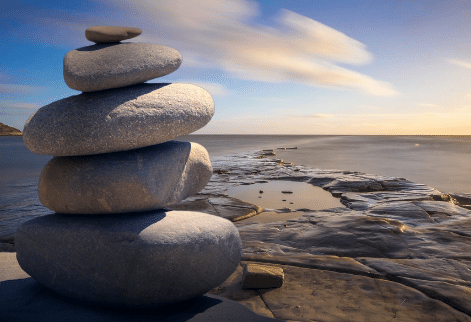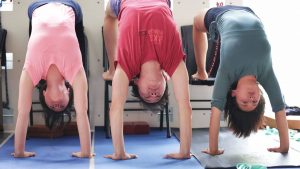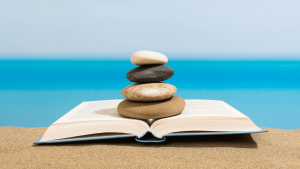Even if you’ve been a yoga practitioner for some time, you’ve likely come across words in class you’ve not recognised or don’t know what they mean.
Common questions Peter gets asked in his yoga and pranayama meditation classes in Melbourne and online revolve around the philosophical concept of yoga, the names and meanings of poses, and understanding different types of yoga practice.
Whether you want to better understand the connection of body, mind and spirit, be able to tell Prana from Apana, or are simply looking for some yoga and meditation inspiration, this blog is for you. We invite you to read on.

Yoga philosophy: Body, mind, and spirit
While the Western world often uses the word “yoga” to be synonymous with asanas, physical fitness, and stress relief, traditional yoga focuses on meditation and living in freedom with all walks and aspects of life.
The weaving together of body, mind, and spirit, the understanding that all are one and cannot be separated, is at the heart of yoga and its philosophy. It’s essentially a concept for the art of living, finding harmony between mind and body, people and nature, realising your “true self”, and achieving mastery over your destiny.
Someone who is in yoga experiences this oneness of existence and is living in a state of freedom (called Nirvana, Moksha, or Mukti).
Popular Yoga Styles
From its origins as a traditional discipline to nurture body, mind, and spirit, many different forms of yoga are being practised today. Where to start? For some yoga class inspiration, we’ve picked a couple of the most common ones for you and will also delve into those Peter is offering in his Melbourne yoga classes.
It’s important to note here that Peter can adapt any style of yoga to enhance your experience. Whether you have a medium level of experience or a seasoned practitioner, Peter is a compassionate and experienced teacher. He will guide you through yoga and meditation and help you develop your practice.
IYENGAR YOGA
Expect a greater focus on mastering a pose and developing strength holding it in Peter’s Iyengar yoga classes. Iyengar style yoga has a slower pace than other styles of yoga, and postures are executed deliberately. The emphasis here is on helping to improve posture and align the body while it’s becoming stronger.
HATHA YOGA
Hatha yoga remains the most popular style, especially with people trying yoga for the first time. Asanas are simple, and emphasis is on introducing people to all the traditional aspects of yoga: breathing, relaxation and meditation, and body awareness.
YOGA JIVANA
The word “Jivana” comes from Sanskrit and is a term for “the experience of life”. It centres around the idea that happiness is naturally within all human beings, and life should lead us to inner happiness. With that in mind, yoga jivana workshops are open to all levels of yoga practitioners and focus on asana, pranayama, and meditation to support a healthy and happy lifestyle.
Know your Apana from your Prana – common yoga terms
Apana refers to a downward force, the energy that runs from your top to the very bottom. Poses that ground you may use Apana.
Prana translates to ‘vital life force or energy and is often seen as the opposite of Apana, an upward energy force. Breathing slowly and steadily encourages your prana to keep moving through your body during yoga practice.
Asana. Although the literal translation of asana from Sanskrit means ‘seat’, it refers to physical postures and poses practised during yoga. It usually describes a single pose or a sequence of poses, such as “downward-facing dog”, for example.
Pranayama refers to breathing techniques. The Sanskrit word prana translates loosely to ‘life force’, whereas Yama means ‘to control’. It can be easy to forget to breathe when you concentrate on holding a yoga pose, but it forms a hugely important part of yoga practice. It can reduce stress, leave you feeling energised, improve brainpower, and much more.
Surya namaskar is better known as the sun salutation. It is a specific sequence of movements and positions intended to draw your energy for the day from the sun and get your complete workout. The sun salutation flow includes every organ and every system in your body and gives you the total workout for body, mind, and spirit.
Bandha means lock, to tighten, or to close off; bandhas are internal muscular locks. When engaged, they support the toning and strengthening of strategic areas of your body. The four main bandhas are in the pelvic floor muscles, the abdominal muscles up to the diaphragm, and the throat. The fourth, Maha Bandha, refers to all three locks simultaneously. Bandhas are used to gain control and lock your prana – your energy.Savasana probably doesn’t need any introduction! It is often the final pose in a yoga class, a restorative pose there to relax. It is also said to help increase focus and concentration and improve memory. Always leave your palms facing up to be open to receive energy from the universe.

Before you go
Before you leave us, which terms and definitions have we missed? Are you still unsure of some of the words used during your meditation or yoga class? If so, let us know. We would love to hear from you.
And if you have questions with regards to Peter’s yoga and pranayama meditation classes or would like to book a private session, please book your session online.



